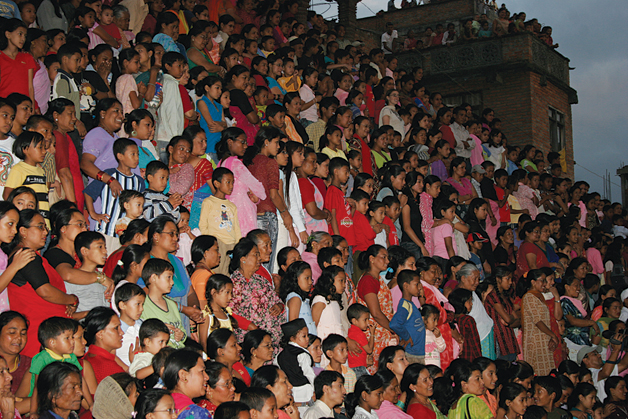
Chandra Shumsher Rana ruled Nepal with an iron fist for twenty eight years between 1901 and 1929 AD. He is known among other things as the builder of Singha Durbar where the Nepali government resides today as well as for ending slavery and the Hindu tradition of Sati, where the widow jumps into the funeral pyre of her dead husband. He was educated in Calcutta and also had an honorary doctoral degree in Civil Law from Oxford University, and he decided to conduct a national census for Nepal in 1920 AD. For this purpose, in 1919, the “Census Goswara” was established with the purpose of “keeping records of men, women, cattle, places and land”.
According to the census returns of 1920 AD, the number of houses in the Kathmandu valley was 64,440 while the population was counted as 306,909 persons. One needs to recall that during the reign of the Rana regime, there were daily curfews in Kathmandu and people did not have the freedom to move in and out of the valley. No one really knows how many people live in the valley in 2006. There is a very large floating population and only during the festivals of Dashain and Tihar when many people leave for “home” do we get a sense of the local population. Many also have houses here and in the districts as well. Since 1997 when the armed conflict began in Nepal, many children were moved to schools in the valley. To avoid having to join either side of the conflict, many Nepalis left to work abroad. In a single day, the number of people “flying out” was as high as 514.
The result of the census carried out in 1920 was recorded by Percival Landon in his book on Nepal published in 1928 in London. According to these tables, Palpa and Gulmi in western Nepal had a population of 376,900 which was much greater than that of the Kathmandu valley. Similarly in eastern Nepal, the hill settlement of Dhankuta had a population of 353,062, again greater than the valley population. It was only in the 1950s, with the eradication of malaria in the tarai, that people were encouraged to move down to the plains and settle near the Indian border. The numerous towns and massive deforestation that Nepal witnessed in the last century are a direct result of this policy.
Kathmandu valley on the other hand got a huge migration population because after 1950, the administrative powers began to be centralized here. Then tourism created hotels, restaurants and attracted job seekers. With the growing demand for carpets in Europe, a huge number of weavers moved into the valley. The armed conflict of the past 10 years really accelerated this process and people estimate that the valley today has a population that ranges between 2 and 3 million, which is ten times higher than in 1920 AD. No wonder all the city infrastructures are under stress. Water shortage, garbage collection, the state of the Bagmati, and air pollution are all indicators of this stress.
In 1920, the terai towns were not small either. Birgunj and the adjoining areas of Bara, Parsa, and Rauthat had a population of 414,657; again much larger than the Kathmandu valley. Similarly Mahotari and Sarlahi had a population of 471,292 and Saptari 377,855. On the other hand fast growing areas today such as Chitwan in the inner tarai had a population of only 20,520 in 1920. The rising human population of Chitwan is inversely proportional to the number of rhinos which a recent census counted at just 370. The number is fast declining with increasing poaching activities and a growing market for wildlife parts. The system of protected areas has become islands in a sea of humans and their ever increasing demand for arable land.
Looking at the whole of Nepal, the 1920 census states that there were a total of 957,609 houses and the population was stated to be 5,573,791. We can see that the numbers were not even rounded off. It seems that every Nepali was actually counted to come up with a figure that accurate. There is a footnote in the book stating that the number of houses was taken from the 1910 census. Today Nepal’s population stands at about 25 million. For a country with so much snow and mountains, the density is very high. At 25 million, there are over 60 countries whose population is far less than Nepal. Clearly the Nepali population has grown five folds since 1920. That is a lot of Nepalis to feed, clothe, educate and care for.
The Kathmandu valley towns of Kathmandu, Patan and Bhaktapur, according to the 1920 census, states that each of them had a population of 108,805, 104,928 and 93,176 respectively. Today Kathmandu and Patan have grown into one city only separated by the Bagmati River, while Kirtipur and Thimi have become big enough to have separate city status. In order to manage the stress on the valley and to ensure a more equitable development for Nepal, it may make sense to use the current political developments to build and shift Nepal’s new capital to the Dang valley in west Nepal. West Nepal could surely benefit from the added investment.
Anil Chitrakar is a founding member of Kathmandu 2020 and
has launched Crafted in Kathmandu to help local artisans.
For comments e-mail: rosha@craftedinkathmandu.com









